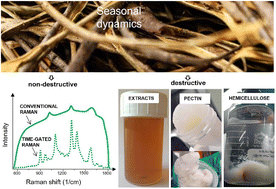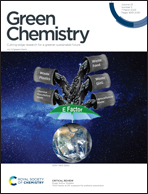Seasonal dynamics in structural characteristics within bark stems of cultivated willow (Salix sp.) by NMR and time-gated Raman spectroscopy†
Abstract
The present study measures the seasonal dynamics of the chemical characteristics of pectin, hemicellulose, starch, protein, and soluble carbohydrates in the tissues of Scandinavian willow bark, which were examined during a complete annual cycle. Wet-chemical purification and non-destructive time-gated (TG) Raman spectroscopy were applied to illustrate the chemical characteristics as a response to the seasonal effect. Starch was found in a more complex linkage connection with hemicellulose and pectin in non-winter seasons, which is also supported by TG Raman spectroscopy. Interestingly, TG Raman spectroscopy also revealed that protein is more prominent in winter-harvested willow bark. The most striking seasonal effect investigated was in the structural characteristics of pectin. The pectin of winter-harvested willow bark has a larger proportion of the highly branched rhamnogalacturonan I (RG-I) domain compared to non-winter-harvested pectin. The study aims to build on this structural knowledge to provide seasonal-tailored enzymes and treat willow bark biologically so that sclerenchyma fibre bundles can be isolated. We demonstrate here for the first time that a combination of non-destructive TG Raman and wet-chemical purification identification methods provides more knowledge about the compositional changes throughout the seasonal variation of compounds in willow bark. The correlation between the seasonal dynamics and the structure of pectin from willow bark is discussed for the first time, which provides the essential knowledge required for optimizing the microbial consortium in valorizing willow bark that can possibly be harvested from multiple seasons.



 Please wait while we load your content...
Please wait while we load your content...